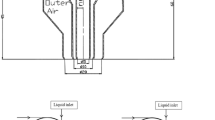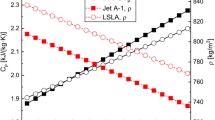Abstract
Thermal cracking of China No.3 aviation kerosene was studied experimentally and analytically under supercritical conditions relevant to regenerative cooling system for Mach-6 scramjet applications. A two-stage heated tube system with cracked products collection/analysis was used and it can achieve a fuel temperature range of 700–1100 K, a pressure range of 3.5–4.5 MPa and a residence time of approximately 0.5–1.3 s. Compositions of the cracked gaseous products and mass flow rate of the kerosene flow at varied temperatures and pressures were obtained experimentally. A one-step lumped model was developed with the cracked mixtures grouped into three categories: unreacted kerosene, gaseous products and residuals including liquid products and carbon deposits. Based on the model, fuel conversion on the mass basis, the reaction rate and the residence time were estimated as functions of temperature. Meanwhile, a sonic nozzle was used for the control of the mass flow rate of the cracked kerosene, and correlation of the mass flow rate gives a good agreement with the measurements.
Similar content being viewed by others
References
Wagner W R, Shoji J M. Advanced regenerative cooling techniques for future space transportation systems. AIAA-1975-1247, 1975
Lander H, Nixon A C. Endothermic fuels for hypersonic vehicles. J Aircraft, 1971, 8(4): 200–207
Huang H, Spadaccini L J, Sobel D R. Fuel-cooled thermal management for advanced aero-engines. ASME J Eng Gas Turb Power, 2004, 126(2): 284–293
Zhou P, Crynes B. Thermolytic reactions of dodecane. J I&EC, 1986, 25(2): 508–514
Stewart J, Brezinsky K, Glassman I. Supercritical pyrolysis of decalin, tetralin and n-decane at 700–800 K product distribution and reaction mechanism. Combust Sci Tech, 1998, 136(1–6): 373–390
Dahm K, Virk P, Bounaceur R, et al. Experimental and modeling investigation of the thermal decomposition of n-dodecane. J Anal Appl Pyrolysis, 2004, 71(2): 865–881
Ward T, Ervin J, Striebich R, et al. Simulation of flowing mildly-cracked normal alkanes incorporating proportional product distributions. J Propul Power, 2004, 20(3): 394–402
Sheu J C, Zhou N, Krishnan A, et al. Thermal cracking of norpar-13 under near-critical and supercritical conditions. AIAA-1998-3758, 1998
Tran L, Chen L. Heat transfer calculation of an endothermic fuel at supercritical conditions. AIAA-1998-3762, 1998
Fan X J, Yu G, Li J G, et al. Investigation of vaporized kerosene injection and combustion in a supersonic model combustor. J Propul Power, 2006, 22(1): 103–110
Fan X J, Yu G, Li J G, et al. Combustion and ignition of thermal cracked kerosene in supersonic model combustors. J Propul Power, 2007, 23(2): 317–324
Shapiro A H. The Dynamics and Thermodynamics of Compressible Fluid Flow. New York: John Wiley & Sons, 1953
Fan X J, Yu G, Li J G, et al. Effects of entry conditions on cracked kerosene-fueled supersonic combustor performance. Combust Sci Tech, 2007, 179(10): 2199–2217
Zhong F Q, Fan X J, Yu G, et al. Heat transfer of aviation kerosene at supercritical conditions, AIAA-2008-4615, 2008
Edwards T. Liquid fuel and propellant for aerospace propulsion: 1903–2003. J Propul Power, 2003, 19(6): 1089–1107
Ely J F, Huber M L. NIST standard reference database 4-NIST thermophysical properties of hydrocarbon mixtures. Nat Inst Stand Tech, 1990
Edwards T, Anderson S. Results of high temperature JP-7 cracking assessment. AIAA-1993-0806, 1993
Author information
Authors and Affiliations
Corresponding author
Additional information
Supported by the National Natural Science Foundation of China (Grant Nos. 10672169 and 10742003)
Rights and permissions
About this article
Cite this article
Zhong, F., Fan, X., Yu, G. et al. Thermal cracking of aviation kerosene for scramjet applications. Sci. China Ser. E-Technol. Sci. 52, 2644–2652 (2009). https://doi.org/10.1007/s11431-009-0090-8
Received:
Accepted:
Published:
Issue Date:
DOI: https://doi.org/10.1007/s11431-009-0090-8




